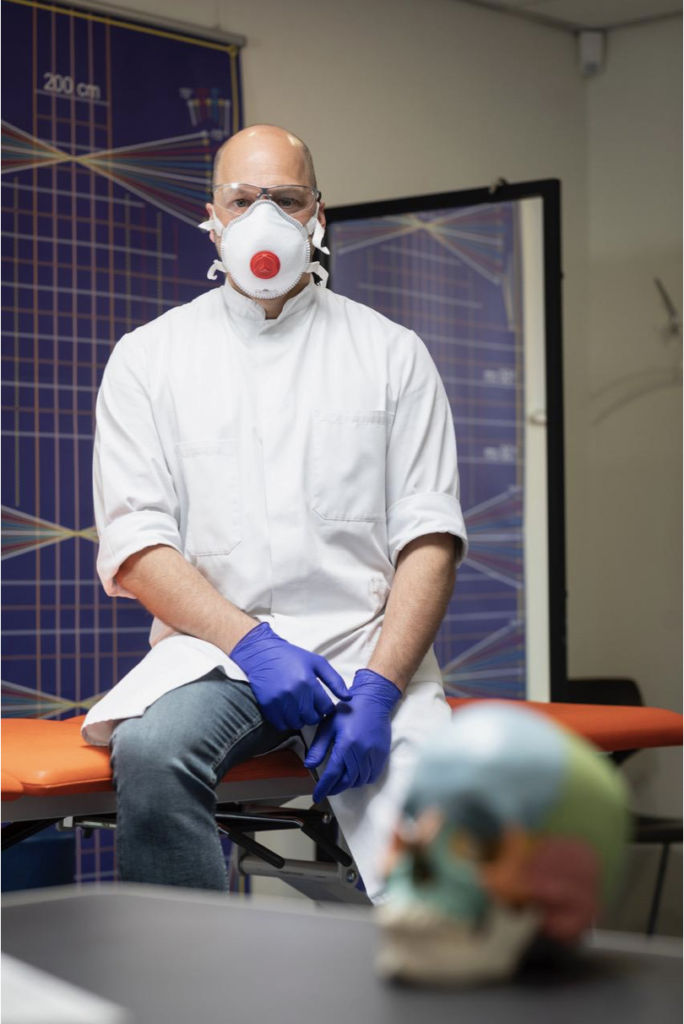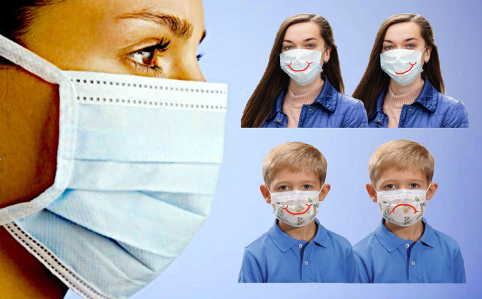Introduction
As we all face new challenges due to the current COVID-19 pandemic, more and more clinical thoughts and challenges arise. Next to possibilities and applications of technology such as telehealth or the use of virtual reality, the safety of patients and the therapists has to be considered, especially when a progressive return to face-to-face therapy occurs (Eccleston et al., 2020; Haines & Berney, 2020).
Another point that has to be considered is the way we cover our faces by (surgical) masks, which cover our mouth and nose so only the eyes and forehead are free. Whereas the common use of face masks is established in Asian countries (Yang, 2020) their everyday use is still unusual in the rest of the world. The World Health Organization (WHO) is constantly adapting its recommendation of when and how to use different kinds of masks during the ongoing pandemic (WHO, 2020). Different guidelines in several countries recommend using face mask protection for the patients and the therapists during face-to-face work but this normally applies to the acute care setting and patients (Physio Austria, 2020).
We may ask ourselves what’s happening with our nonverbal communication considering that most of our emotions and feelings are expressed by the face. In this blog we discuss some thoughts and ideas about how to deal with this situation in daily clinic in the future.
Our face as a communication tool
Our face has the unique ability to communicate in a nonverbal manner (von Piekartz & Mohr, 2014). Nonverbal communication is dependent on facial emotional expression, that often works as an early warning system and shows us how the person might feel at the moment (von Korn et al., 2014). Empirical evidence confirms that our own facial expressions modulate our emotional experiences (Price et al., 2015). For instance, observing a smile may facilitate bodily motor responses (smile) which is called facial mimicry, an emotional response (happiness) and other physical reactions like autonomic arousal (sweating and heart rate changes). Besides storing this somato-sensory-motor experience, the brain scrutinizes it against millions of other previous facial mimicry experiences, which leads to subtle individual non-verbal communication and empathy (Wood et al., 2016).
Various studies have shown, that our first reflex in scanning another person’s face is to look mainly at the eyes and mouth. From an evolutionary point of view, we assess whether there is a threatening situation (Ross et al., 2007). The lower part of our face (the region of the mouth) plays an important role for the recognition of disgust, anger and happiness (Wegrzyn et al., 2017).
What is the effect of covering our face?
Partial covering (occlusion) of faces (particularly the eyes and mouth) influences the accuracy and speed of the recognition of emotions in children and adults (Roberson et al., 2012). In general, mouth occlusion causes a greater decrease in facial expression recognition than the occlusion of the eyes. Mouth occlusion affects especially anger, fear, happiness and sadness, while eye occlusion affects mainly feelings of disgust (Kotsia et al., 2007). This data is the result of clinical research and mostly occurred during short time face occlusion. There is no long-term face occlusion data available, but people with general chronic pain, facial pain, Parkinson’s disease, facial paresis, depression or following stroke are less accurate and slower in emotion recognition and expression. This may lead to emotion blindness referred to as Alexithymia (Taylor & Bagby, 2004).
 Partially covering our face can be reflexive and mostly involves occluding the mouth. This can help us cover our real emotion, especially if we are in a situation where we feel that we are not allowed to express our emotions, because of cultural norms or values,
Partially covering our face can be reflexive and mostly involves occluding the mouth. This can help us cover our real emotion, especially if we are in a situation where we feel that we are not allowed to express our emotions, because of cultural norms or values,
Examples include, somebody tells you a joke during a classical music concert and you have to try to stop yourself from laughing. Or when you smell unpleasant odors coming from food cooked for you by a dear friend. This phenomenon is referred to as ‘facial blending’ (Ross et al., 2007).
Could wearing surgical masks have real consequences for us in our society?
The prospect of long term global face mask use poses some very interesting questions. Could regular and wide spread wearing of surgical masks influence or change our facial mimicry and lead to a kind of alexithymia (inability to recognise or describe one’s own emotions) – let’s say, ‘surgical mask Alexithymia’ based on the Russell Model (2003)? Will our emotions be flatter and less intense and show less changes in the balance of negativity?
Might we lose some of our human individuality with our unique variability and intensity of emotions lost in a world ‘locked down’ by a pandemic situation with no time limit?
Long term face pain and surgical masks. May it lead to increased body distortion?
As there exists quite good evidence that chronic pain might lead to body disruption and vice versa, we might have to think about possible consequences in adaptations in the sensorimotor and somatosensory system (Bray & Moseley, 2011; Linder et al., 2016; Wallwork et al., 2016). Those changes occur as well in patients with low back pain, complex regional pain syndrome but also during chronic cranio- and/or orofacial disorders (Moseley & Flor, 2012; H. von Piekartz et al., 2015). As it is not all about emotion, but also because of a lack in motor function, nonetheless the wearing of masks might influence both aspects.
It may be hypothesized that long time (face) pain experience, lack of facial mimicry may increase unexpected smudging of the affected body part which we don’t know how it develops like the prognoses of the development as the coronavirus itself. Clinicians who work with head-face -neck patient may be aware that (a) typical somato-emotional -motor patterns what slowly emerge which are not be recognized by the medical society. Some tips beforehand are discussed in the text below
What are some possible consequences for therapists treating people experiencing pain
Facial occlusion in a fearful pandemic society with no time limit may have a strong impact for patients in pain and clinicians.
Some questions we may ask ourselves:
- Will masks, worn by therapists and patients, disturb communication, due to lack of facial reflexes and mood estimation?
- Do facial expression restrictions have consequences for the quality of life of patients with for example Temporomandibular joint Disorder (TMD), bruxism, traumatic face pain, headache or other acute or chronic pain states?
- Depression and catastrophizing often are comorbidities in this patient group. Does wearing masks have more impact on their symptoms?
- How can we recognize or test if changed emotional responses are contributing to the patient’s symptoms?
- If we recognize any such consequences, what are the possibilities for intervention?

- How do we accommodate the the consequences of facial occlusion by masks during Explain Pain and other educational interventions?
- Do we need to test for changes in emotional recognition and expression and any possible change of cognitive style patients use?
- When emotion recognition and expression are blurred, can we train these with facial motor function training, motor imagery and emotion training.
Maybe there are more questions to ask, so please don’t hesitate to ask us questions in the comments below.
Testing and Training
There are established methods for testing and training facial emotion recognition skills that may have a role to play as we consider these challenges:
- In psychological studies the Reading-the-Mind-in the-Eyes Test is often used which shows a good accuracy of recognizing the emotional and behavioural state in the person’s eyes (Sato et al., 2016);
- The Facially Expressed Emotion Labeling (FEEL) Test, which is a computer-based test, measures one’s ability to recognize facially expressed basic emotions (Braun et al., 2005);
- My facetraining (https://www.myfacetraining.com) is a software program for PC and mobile devices as an APP, where the emotion recognition/expression can be tested and transformed in training. It has also a mirror function!
- Face training App CRAFTA® is a simple APP to test and to train laterality and basic emotions.
- NOI Group Recognise APPs for hand, feet, neck and back are well established and easy to use for testing and treatment purpose.
Conclusion
- Clinicians should be aware that facial deprivation during the COVID-19 pandemic in combination with imposed social restriction for an indefinite time may have a profound impact on quality of life and pain, especially in chronic pain sufferers.
- Clinicians should be aware of possible new clinical patterns;
- Clinicians could consider applying standardized tests to evaluate the emotion responses and train these if necessary.
Do you have ideas or thoughts on this topic? Please share these and ask questions in the comments below.
–Bernhard Taxer, MSc PT, PhD Cand, Austria
-Harry von Piekartz , PhD, MSc PT, The Netherlands
References
Braun, M., Traue, H. C., Frisch, S., Deighton, R. M., & Kessler, H. (2005). Emotion recognition in stroke patients with left and right hemispheric lesion: Results with a new instrument—the FEEL Test. Brain and Cognition, 58(2), 193-201.
Bray, H., & Moseley, G. L. (2011). Disrupted working body schema of the trunk in people with back pain. British Journal of Sports Medicine, 45(3), 168–173. https://doi.org/10.1136/bjsm.2009.061978
Eccleston, C., Blyth, F. M., Dear, B. F., Fisher, E. A., Keefe, F. J., Lynch, M. E., Palermo, T. M., Reid, M. C., & Williams, A. C. de C. (2020). Managing patients with chronic pain during the Covid-19 outbreak: Considerations for the rapid introduction of remotely supported (e-health) pain management services. PAIN, Articles in Press. https://doi.org/10.1097/j.pain.0000000000001885
Haggard, P., Taylor-Clarke, M., & Kennett, S. (2003). Tactile perception, cortical representation and the bodily self. Current Biology, 13(5), R170–R173. https://doi.org/10.1016/S0960-9822(03)00115-5
Haines, K., & Berney, S. (2020). Physiotherapists during COVID-19: Usual business, in unusual times. Journal of Physiotherapy. https://doi.org/10.1016/j.jphys.2020.03.012
Kotsia, I., Buciu, I., & Pitas, I. (2008). An analysis of facial expression recognition under partial facial image occlusion. Image and Vision Computing, 26(7), 1052-1067.
Linder, M., Michaelson, P., & Röijezon, U. (2016). Laterality judgments in people with low back pain – A cross-sectional observational and test–retest reliability study. Manual Therapy, 21, 128–133. https://doi.org/10.1016/j.math.2015.07.001
Luomajoki, H., & Moseley, G. L. (2011). Tactile acuity and lumbopelvic motor control in patients with back pain and healthy controls. British Journal of Sports Medicine, 45(5), 437–440. https://doi.org/10.1136/bjsm.2009.060731
MacIver, K., Lloyd, D. M., Kelly, S., Roberts, N., & Nurmikko, T. (2008). Phantom limb pain, cortical reorganization and the therapeutic effect of mental imagery. Brain, 131(8), 2181–2191. https://doi.org/10.1093/brain/awn124
Moseley, G. L., & Flor, H. (2012). Targeting Cortical Representations in the Treatment of Chronic Pain: A Review. Neurorehabilitation and Neural Repair, 26(6), 646–652. https://doi.org/10.1177/1545968311433209
Physio Austria. (2020). Coronavirus: LAUFEND neue Informationen für PhysiotherapeutInnen | physioaustria.at. https://www.physioaustria.at/news/coronavirus-laufend-neue-informationen-fuer-physiotherapeutinnen
Price, T.F. and Harmon-Jones, E. (2015) Embodied emotion: the influence of manipulated facial and bodily states on emotive responses. Wiley Interdiscip. Rev. Cogn. Sci. 6, 461–473
Roberson, D., Kikutani, M., Döge, P., Whitaker, L., & Majid, A. (2012). Shades of emotion: What the addition of sunglasses or masks to faces reveals about the development of facial expression processing. Cognition, 125(2), 195-206.
Ross ED, Prodan CI, Monnot M. (2007): Human Facial Expressions are organized functionally across the upper-lower facial axis. Neuroscientist, Vol. 13(5): 433-446
Russell, J. A. (2003). Core affect and the psychological construction of emotion. Psychological Review, 110, 145–172.
Sato, W., Kochiyama, T., Uono, S., Sawada, R., Kubota, Y., Yoshimura, S., & Toichi, M. (2016). Structural Neural Substrates of Reading the Mind in the Eyes. Frontiers in Human Neuroscience, 10, 151. https://doi.org/10.3389/fnhum.2016.00151
Taylor, G. J., & Bagby, R. M. (2004). New trends in alexithymia research. Psychotherapy and psychosomatics, 73(2), 68-77.
von Korn, K., Richter, M., & von Piekartz, H. (2014). Einschränkungen in der Erkennung von Basisemotionen bei Patienten mit chronischem Kreuzschmerz. Der Schmerz, 28(4), 391–397. https://doi.org/10.1007/s00482-014-1395-5
von Piekartz, H., Wallwork, S. B., Mohr, G., Butler, D. S., & Moseley, G. L. (2015). People with chronic facial pain perform worse than controls at a facial emotion recognition task, but it is not all about the emotion. Journal of Oral Rehabilitation, 42(4), 243–250. https://doi.org/10.1111/joor.12249
von Piekartz, Harry, & Mohr, G. (2014). Reduction of head and face pain by challenging lateralization and basic emotions: A proposal for future assessment and rehabilitation strategies. The Journal of Manual & Manipulative Therapy, 22(1), 24–35. https://doi.org/10.1179/2042618613Y.0000000063
Wallwork, S. B., Bellan, V., Catley, M. J., & Moseley, G. L. (2016). Neural representations and the cortical body matrix: Implications for sports medicine and future directions. British Journal of Sports Medicine, 50(16), 990–996. https://doi.org/10.1136/bjsports-2015-095356
WHO. (2020). When and how to use masks. https://www.who.int/emergencies/diseases/novel-coronavirus-2019/advice-for-public/when-and-how-to-use-masks
Yang, J. (2020). A quick history of why Asians wear surgical masks in public. Quartz. https://qz.com/299003/a-quick-history-of-why-asians-wear-surgical-masks-in-public/


There are clear masks available, to help the deaf lip read when we have to wear masks. Maybe clear masks could be used by anyone. Google clear mask.
I like the comment about clear masks. I managed to get some face shields as an option. In my local grocery all employees have option of those or masks and many choose the shields.
There are clear masks available, so that deaf people can lip read when we have to wear masks. Perhaps we can all wear clear masks, to help with reading facial expressions. Google clear mask to see examples.
I am surprised that none of the studies refer to the obvious analogy of face-coverings worn by women in public in some Muslim countries. This would seem to be a more relevant cohort than people with facial pain, as it is likely that face-coverings will be only necessary in public and normal facial expression interaction would continue in private settings. It would be interesting to understand whether any of the effects postulated in this article are shown to persist amongst women who habitually wear niqabs in public.